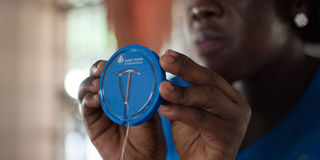Use a trained medic when choosing IUDs

An IUD can be inserted right after you give birth, whether you have delivered vaginally or by c-section. All this information and more should be given by a health expert before insertion. STOCK PHOTO
What you need to know:
- Women must be fully informed about the intrauterine device before choosing it and health care workers must be adequately trained to insert it.
- Later, the doctor informed Muhindo that he had successfully removed the IUD and she paid her bill. A few days later, though, her husband had to drive her to another hospital for emergency treatment. “I was suffering from terrible abdominal pains. It turned out that the doctor had pushed the IUD deeper into my uterus. I had to undergo surgery to remove it.”
As a long term method (can last 10 years but can be removed at any time), an intrauterine device (IUD) would ideally be the best contraceptive. However, it is shunned by many women because of the horror stories, myths and misconceptions associated with it. The fact that few health workers trained in how to insert and remove IUDs is also a deterrent.
After the birth of her son, Olivia Mukisa wanted a long term contraception method. “After examining me, my gynaecologist said my uterus is too small to comfortably contain an IUD. I was glad that he explained everything to me, including why it was risky for me to use IUDs. I made an informed choice to have it inserted.”
Mukisa adds that because of her uterus size, the process was very painful. “The doctor cautioned me to only have a trained health worker to remove it. It is now three years since it was inserted.” Success stories such as Mukisa’s are common. However, not every user is lucky to have the benefit of a trained health worker. Lucy Muhindo went through a nightmare at a hospital in Kampala. “After using an IUD for two years, I wanted to have a baby.
Because it was a big hospital, I assumed the doctors knew how to remove IUDs. However, for about 30 minutes, the doctor and a nurse fidgeted, trying to locate and pull on the strings.”
Later, the doctor informed Muhindo that he had successfully removed the IUD and she paid her bill. A few days later, though, her husband had to drive her to another hospital for emergency treatment. “I was suffering from terrible abdominal pains. It turned out that the doctor had pushed the IUD deeper into my uterus. I had to undergo surgery to remove it.”
The fear
Muhindo is not alone. Many women are afraid of using IUDs. Dr Dina Nakiganda, the assistant commissioner for reproductive health in the Ministry of Health, says this fear comes from myths.
“I do not think a doctor can push an IUD into the uterus. It is not true that an IUD can move. We are now using automated technology. Majority of women have a standard uterus so once the inserter is in position, it just spreads out. Removing the IUD is much easier because the nurse can gently pull the string when the mouth of the uterus is open, usually during menstruation,” she says.
Silas Gogo, a sexual reproductive health service provider with Reproductive Health Uganda in Apac District, says the biggest instigator of the fear is the biased communication about IUDs.
“It is true that most women do not want to expose their nakedness to service providers as the IUD is being inserted. However, because many health workers do not know how to insert IUDs, they do not tell women about their availability. They will list all the family planning options and then, tell them about IUDs as an afterthought.”
Dr Nakiganda puts this down to the small number of workers in government health facilities, saying: “Inserting an IUD takes a long time so the nurse will advise the woman to use a short term method such as an injectable, which takes less than a minute to administer, so that she can rush and attend to other duties such as immunising children.”
Training health workers
According to Dr Nakiganda, the Ministry of Health and its partners regularly trains health workers in IUD insertion and removal.
“Last year, we had training for administering a broad range of contraceptive commodities. However, I must admit that only 25 per cent of government health workers can comfortably insert and remove IUDs. Most of the people at health centres who can insert IUDs belong to our partners such as, Marie Stopes.”
As part of their training, health workers are given a two-week course on how to insert IUDs. However, most of it is theory, though. “We have health workers with no practical experience and yet the uterus is very delicate,” Gogo says, adding, “One small mistake can perforate it. Because of the fear of making mistakes, most health centres do not provide IUDs.”
The uterus has three layers. The IUD is supposed to be gently placed against the outer layer. Gogo says an inexperienced health worker, when removing the IUD, may damage the uterus.
Some of the symptoms of an IUD in the wrong place include intense cramps and pain and heavy vaginal bleeding. However, training health workers, both government and private, in inserting and removing IUDs will boost their confidence and increase the clients’ satisfaction and comfort when using this contraception method.
How to check
Silas Gogo, a sexual reproductive health service provider with Reproductive Health Uganda in Apac District, says if properly inserted, IUDs are a good birth control method because they do not tamper with the hormones. “With an IUD, one will continue to have regular menstruation. After a menstrual cycle, insert your finger into your uterus to feel for the IUD string. If you cannot touch it, visit your gynaecologist immediately.”




